Why the 2020 global biodiversity policy failed and how to improve for 2030
This year, experts and representatives from all over the world are planning to meet at the Conference of Parties (COP15) in Kunming, China. The goal is to negotiate on the most important global targets to halt biodiversity decline by 2030. A tough nut to crack, as the past decades have shown us. Researchers are presenting their recommendations to set ambitious, but achievable targets. Will we be able to learn from previous mistakes?
Please also read: Achieving a Global Deal for Nature?
United Nations Convention on Biological Diversity
Back in 1992, the United Nations founded the Convention on Biological Diversity during their summit in Rio de Janeiro. In this Convention, members agreed on global strategies to slow down and halt the biodiversity loss. Ten years later, in 2002, the states revised and renegotiated the target and goals. As an outcome, members agreed on a biodiversity target for 2010. Another eight years later, the target was far from being met, and 20 new and more ambitious goals were set for 2020. Yet, the UN member states concludes in 2019 that the world will miss this target too. Meanwhile, global biodiversity decline continues at unprecedented rates.
Why did the global biodiversity target 2020 fail?
Researchers presented their analysis on why the world was not able to meet its 2020 target. The conclusion was that UN members states insufficiently incorporated the goals into national laws. Only 22% of the national plans to meet the Aichi targets were strict enough to meet the actual decisions. Of the twenty goals, the so-called Aichi Targets, four were not reflected in any of the countries’ plans. One of them being the phasing out of subsidies for activities that harm the environment. Furthermore, there were insufficient financial resources and major knowledge gaps to properly address the goals and bring biodiversity to a halt. The reason why this was not noticed earlier, is due to the lack of proper monitoring. In some cases, countries did not have effective indicators and evaluation plans to monitor their progress.
Learning from the past, improving the future
As the Convention reflects on the 2020 target in their first post-2020 report, we can see that there have been many improvements. Yes, countries are working towards the goals to halt biodiversity, but not in a clear and structured way. As the researchers conclude, governments fail to present clear roadmaps how to achieve and monitor their goals.
The researchers therefore suggest that the biodiversity target for 2030 should be formulated more concrete and in a practical way. This will allow for easier uptake into national laws, without requiring changes. Of course, the targets should become legally binding, and all states should allocate more financial resources to achieve them. Furthermore, governments should encourage more interdisciplinary research to study the trends and drivers of biodiversity loss. This will help countries to identify new instruments to halt the loss, or develop other novel responses tailored to their challenges.
Reconsidering opportunities with rural development plans
The European Wilderness Society is a partner in the LIFEstockProtect project. Part of this project is also to look into possibilities to use national Rural Development Plans as a financial tool to support sustainable agricultural practices. Currently, only a few countries make use of their RDP to financially support farmers this way. Through the project, the partners aim to present a suggestion to the decision makers on how to improve the situation.









